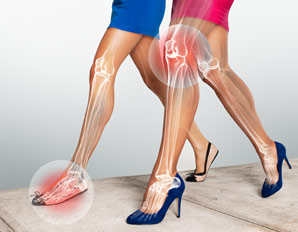HIGH HEELS- Good or Bad – You decide!
Women love high heels as they make us taller, more stylish, feel sexy however there are problems that can arise from wearing high heels on a regular basis?
Wearing high heels is especially stressful on the joints of the foot because all of the body’s weight rests there at an unnatural angle. The foot is then forced into a narrow, pointed shoe, compounding the problem. The wearing of high-heeled shoes is a prime example of women inviting foot problems says doctors of podiatric medicine, who see no value in high heels. They believe them to be biomechanically and orthopedically unsound, citing medical, postural, and safety faults.
They know, for example, that high heels contribute to knee and back problems and disabling injuries in falls. In time, high heels may cause enough changes in the feet to impair their proper function. Most women admit high heels make their feet hurt, but they tolerate the discomfort. Heels force the thigh muscles to work harder, putting extra strain on the knee joint and tendon that runs from the knee cap to the thigh bone. Compared with walking barefoot, high heels increase the pressure on the inside of the knee by an estimated 26 percent. Over time, this increased pressure on the knee can lead to arthritis.
People should take an average of 10,000 steps a day. High heels shift the force of each of those steps so that the most pressure ends up on the ball of the foot and on the bones at the base of the toes (if you wear flats, the entire foot would absorb this impact). A 3-inch heel creates three to six times
more stress on the front of the foot than a shoe with a modest one-inch heel. As a result, heels can lead to:
- bunions,

- heel pain,
- toe deformities,
- shortened calf muscles,
- an awkward, unnatural gait,
- trapped nerves,
- lumber back pain and
- deformity (hyperlordotic posture)
In fact, women account for about 90% of the nearly 800,000 operations each year for bunions, hammertoes (a permanent deformity of the toe joint in which the toe bends up slightly and then curls downward, resting on its tip), and trapped nerves, and most of these surgeries can be linked back to their high-heeled shoe choice.
The problems can travel upward, too. The ankle, knee, and hip joints can all suffer from your footwear preferences. When you walk in flats, the muscles of the leg and thigh have an opportunity to contract as well as to stretch out. However, when wearing your high-heeled shoes, the foot is held in a downward position as you walk. This keeps the knee, hip, and lower back in a somewhat flexed position, which prevents the muscles that cross the backside of these joints to stretch out as they normally would. Over time, this can lead to stiffness, pain, and injury.
High heels can also cause lower back strain, because the heel causes your body to pitch forward more than normal, putting excess pressure on the back. Only a tiny percentage of people are born with foot
problems. Most conditions arise from neglect or simply not knowing how to care for your feet. Women are particularly vulnerable. They have about four times as many foot problems as men do, most of which likely comes from wearing ill-fitting shoes.
Pain in the ball of your foot (metatarsalgia) is often caused by wearing high heels. The higher the heel, the greater the pressure on the ball of your foot. A three-inch heel exerts about 76 percent more pressure than a flat shoe. You can also try a metatarsal pad to help relieve the pain, but it’s also a good idea to change shoe styles to low or flatter heels.
So there are the facts. Make your own decisions as to whether you continue to wear high heels every day, or maybe whether you could save them for special occasions.

